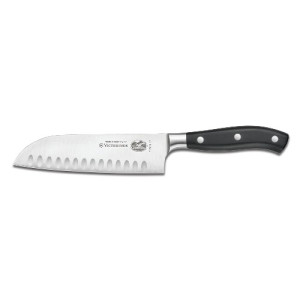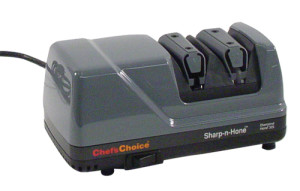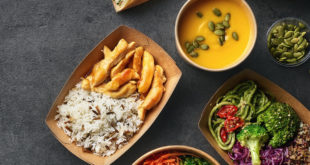What’s the big deal with santoku knives?
A santoku knife is a more versatile version of a cook’s knife, with a thinner blade that allows for finer slicing and mincing. Some chefs swear by the santoku, claiming it has better balance. In general, a cook’s knife is going to be better for larger, heavier chopping and cutting while a santoku blade is best used for thinner chopping and cutting tasks. The “granton” or scalloped blade on a santoku knife makes the blade less sticky when cutting very thin slices, allowing them to peel off the blade more easily.
What does high carbon mean?
High carbon stainless steel, interestingly enough, has a higher carbon content than most other types of stainless steel. This type of steel is used in professional cutlery because it allows the manufacturer to “temper” the blade. Tempering is a heating and cooling process during forging that tapers the blade without making it brittle. Higher carbon steel is more tolerant of this process.
 What is a bird’s beak paring knife?
What is a bird’s beak paring knife?
“Bird’s beak” refers to the downward slant at the tip of the spine of the blade on a paring knife. This type of paring knife makes it easy to peel and cut round objects like fruits and vegetables, and is most often used for garnishes in commercial kitchens.
Is a serrated slicer knife better than a straight edge?
The short answer is that it depends. Serrated edges stay sharp longer but are also more difficult to sharpen. If you’re looking for a good, durable knife that doesn’t slice very thin, then a serrated edge slicer is a good bet. Straight edge slicers are perfect for making paper-thin cuts on a consistent basis, like on a big hunk of roast beef. They dull more quickly and are maybe a little less durable, but when you need thin, straight is the answer.
Why would I want an offset bread knife?
The offset handle on a bread knife means you don’t whack your knuckles on the counter every time you slice a piece of bread. It’s a very nice feature if you’re cutting a lot of bread in a hurry.
How often should I sharpen my knives?
To maintain a perfect cutting edge, use a manual sharpener daily to remove burrs and restore a sharper edge. Over time, however, the blade angle will need to be reset periodically, something an electric knife sharpener is far more effective at accomplishing. As the blade wears down from daily use and daily sharpening, the angle gets larger, which makes it harder to get an edge out of a cursory daily sharpening. A two or three stage electric sharpener restores this blade angle by regrinding the blade. It depends on how much you use your cutlery, but in general the angle should be reset about once a month.
Is a diamond coated grinder better for sharpening?
In a word: yes. A diamond coated grinder shaves away steel at a much cooler temperature than a normal grinder. This is important because heat will “detemper” the steel of a knife blade, making it more brittle and more prone to nicking and dulling.
 Corner Booth Blog | TundraFMP Restaurant Supply, News & Equipment Blog
Corner Booth Blog | TundraFMP Restaurant Supply, News & Equipment Blog




What are the advantages of cheap stamped knives, and more more expensive forged knives?
Hi Dan,
Companies like Victorinox will tell you that a stamped blade is lighter and thinner, making it easier to handle, especially for more inexperienced kitchen staff. That lighter and thinner blade is also going to wear, chip, and even break more easily, but if it’s light prep work we’re talking about here then that’s probably not a huge problem.
Forged blades are heavier, will certainly last longer, and are easier to sharpen over a long period of time without compromising the quality of the edge. Experienced chefs who do heavy duty prep work all day every day will take a forged blade every time.
So each type of blade has its place in a kitchen, depending on the type of work the blade will be doing and who is handling it.